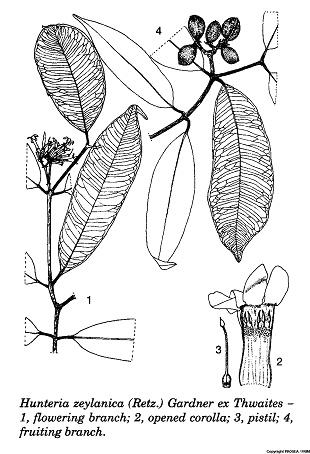Hunteria zeylanica (Retz.) Gardner ex Thwaites
Family
Apocynaceae
Synonyms
Hunteria corymbosa Roxb.
Vernacular Names
| Malaysia | Getah aguh, kayu gading, kemuning hutan (Peninsular). |
| Indonesia | Gitan obat, tahoi (Lampung). |
| Thailand | Muuk khao (Nakhon Ratchasima, Krabi), yaang khaao (Chanthaburi). |
| Vietnam | B[ee]n bai. |
Geographical Distributions
H. zeylanica occurs in eastern Mrica, India, Sri Lanka, Burma (Myanmar), Cambodia, Laos, Vietnam, southern China (Hainan), Thailand, Peninsular Malaysia, the Anambas Islands and Sumatra.
Description
It is a shrub or small tree that can reach up to 15 m tall, with its bole up to 30 cm in diametre and often fluted.
Leaves are arranged opposite, simple and entire, elliptical to oblong or obovate with a size of 2-21 cm x 1-7 cm, cuneate to rounded at base, rounded to acuminate at apex and hairless. The secondary veins are 12-30 pairs and joined into a marginal vein. The petiole is 1-1.5 cm long while stipules are absent.
Inflorescence is terminal, compound, dichasial cyme and many-flowered. Flowers are bisexual, regular, 5-merous and fragrant. Pedicel is 4-10 mm long. Sepals are 1-2.5 mm long and with colleters inside. The 6-10 mm long petal is an almost cylindrical tube, hairy inside below the stamens while spreading lobes are 4-9 mm long, white to pale yellow. The stamens are inserted in the upper part of petal tube while filaments are short. The ovary is superior, composed of 2 separate carpels that unite at the extreme base by a disk-like thickening. Style is up to 7 mm in length, pistil head is composed of a stigmatic subglobose basal part and a stigmoid apex.
Fruit is composed of 2 separate, obovoid to spherical mericarps that are up to 3 cm long. It is stiped at the base, yellow to orange and usually 2-seeded.
Seeds are oblong or ellipsoid, up to 1.5 cm long, smooth and orange. Cotyledons are thin and leafy.
Ecology / Cultivation
H. zeylanica usually occurs in the undergrowth of lowland rain forest, up to 550 m altitude, rarely on limestone. It is locally common, e.g. in parts of Peninsular Malaysia.
Line Drawing / Photograph
References
-
Plant Resources of South-East Asia No.12(3): Medicinal and poisonous plants 3.



